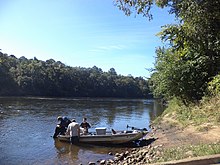Flint River
| Flint River | |
|---|---|
 Jim Woodruff Dam, at the mouth of the Flint River | |
 Map of the Apalachicola River system with the Flint River in dark blue and its watershed highlighted. | |
| Physical characteristics | |
| Source | Flint River |
| • location | College Park, Georgia |
| • coordinates | 33°40′08″N 84°26′24″W / 33.669°N 84.440°W |
| • elevation | 1,027 ft (313 m) |
| Mouth | Apalachicola River |
• location | Lake Seminole |
• coordinates | 30°43′44″N 84°52′30″W / 30.729°N 84.875°W |
• elevation | 77 ft (23 m) |
| Length | 344 mi (554 km) |
| Basin size | 8,460 sq mi (21,900 km2) |




The Flint River is a 344-mile-long (554 km)
Description
The Flint River rises in west central Georgia in the city of
In southwestern Georgia, the river flows through downtown Albany, the largest city on the river. At Bainbridge it joins Lake Seminole, formed at its confluence with the Chattahoochee River upstream from the Jim Woodruff Dam, very near the Florida state line. From this confluence, the Apalachicola River flows south from the reservoir through Florida to the Gulf of Mexico.
The Flint River is fed by Kinchafoonee Creek just north of Albany, and by Ichawaynochaway Creek in southwestern Mitchell County, approximately 15 miles (24 km) northeast of Bainbridge.
In addition to Lake Seminole, the Flint River is impounded approximately 15 miles (24 km) upstream from Albany to form the Lake Blackshear reservoir.
The Flint River is one of only 40 rivers in the nation to flow more than 200 miles (320 km) unimpeded by dams or other manmade systems, and is increasingly valued for that. In the 1970s, a plan by the U.S. Army Corps of Engineers to build a dam at Sprewell Bluff in Upson County was defeated by Jimmy Carter, then the Governor of Georgia, and other supporters. Carter's hometown of Plains is located near the Flint River.
Natural history
The river is considered to have three distinct sections as it flows southward through western Georgia. In its upper reaches in the red hills of the
The river has been prone to
, stuck in trees and other places.Montezuma, Georgia was completely inundated after the Flint River topped the 29-foot levee protecting the town from floodwater. The official depth of the river at the height of the flood was estimated at 34 feet. The nearby gauge was underwater, making it impossible to get an accurate reading. Cleanup and restoration of Albany took months to complete. In 1998 another serious flood occurred in Albany, but it was not as damaging as the one of 1994.[4] Bainbridge also flooded in 1998. Other significant floods occurred in 1841 and 1925.
In January 2002, a winter storm blew through Atlanta the day after New Year's Day. The airport's drainage system overflowed, resulting in deicing fluid leaking into the river. Although the antifreeze entered the drinking water of some residents, no one became seriously ill. The airport changed its drainage system to prevent the problem in the future. No problems were reported after an unusually heavy 4 inches (10 cm) of rain officially fell at the airport at the beginning of March 2009.
In May 2009, the National Fish Habitat Action Plan named the Lower Flint River one of its "10 Waters to Watch" for 2009 for its habitat restoration work. In October 2009, American Rivers placed the Flint on its list of America's Most Endangered Rivers, mainly due to new plans to put a dam on it.[5]
The Flint is one of four rivers in the southeast with significant remaining populations of Hymenocallis coronaria, the Shoals spider-lily. Four separate stands of the plant have been studied and documented in the river, ranging from Yellow Jacket Shoals to Hightower Shoals.[6]
In popular culture
In Gone With the Wind, author Margaret Mitchell describes the Flint River as bordering the fictional plantation Tara.
American
See also
- List of Georgia rivers
References
- ^ U.S. Geological Survey. National Hydrography Dataset high-resolution flowline data. The National Map Archived 2012-03-29 at the Wayback Machine, accessed April 15, 2011
- ^ Thronateeska chapter, Daughters of the American revolution (1924). History and reminiscences of Dougherty county, Georgia. Albany, Georgia: Herald publishing company. p. 16.
- ^ Flint River Archived 2012-09-30 at the Wayback Machine article at the New Georgia Encyclopedia
- ^ "Rain pounds Georgia again, raising flood concerns". USA Today. 2005-04-03.
- ^ Flint River, one of America's Most Endangered Rivers of 2009, still faces critical threats, americanrivers.org American Rivers, archived from the original on December 5, 2010, retrieved February 8, 2010
- ^ Markwith, Scott H.; Scanlon, Michael J. (May 11, 2006). "Multiscale analysis of Hymenocallis coronaria (Amaryllidaceae) genetic diversity, genetic structure, and gene movement under the influence of unidirectional stream flow". American Journal of Botany. Botanical Society of America. Archived from the original on December 20, 2012. Retrieved October 1, 2012.
